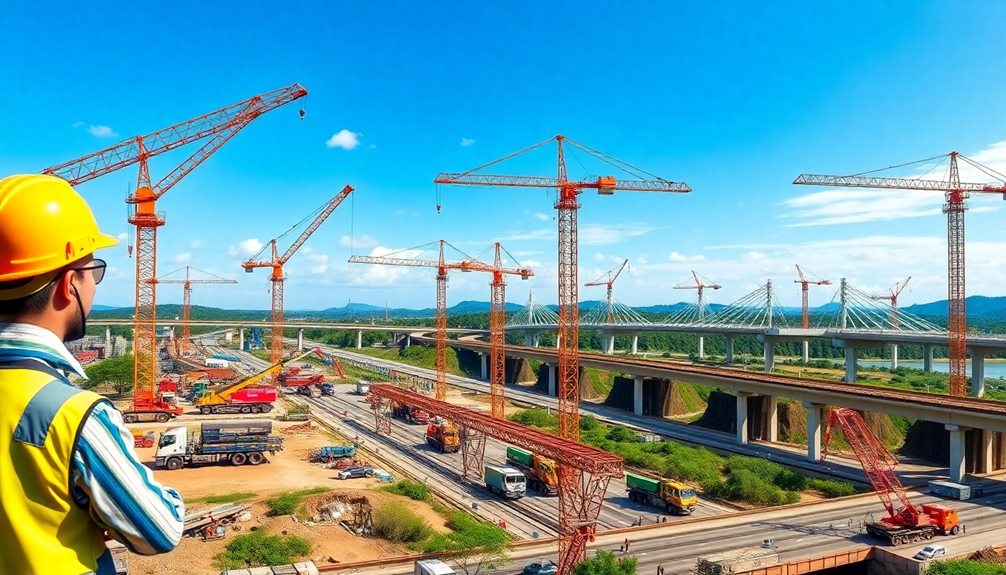The Infrastructure Investment and Jobs Act (IIJA) is a significant boost for America's infrastructure. It allocates $1.2 trillion to modernize critical areas like roads, bridges, broadband, and water systems. You'll see funding for over $110 billion in transportation improvements, $65 billion for expanding broadband access, and $55 billion for upgrading drinking water systems. These investments aim to create jobs, enhance safety, and guarantee cleaner, more reliable services. Plus, there's a strong focus on supporting disadvantaged communities. If you're curious about how these funds will impact your area, keep exploring the details!
Key Takeaways
- The IIJA allocates $1.2 trillion for infrastructure modernization, with $550 billion for new investments in critical areas like transportation and broadband.
- Key investments include $110 billion for repairing roads and bridges, enhancing safety and efficiency across the transportation network.
- The act provides $65 billion for broadband expansion, aiming to improve access for over 30 million underserved Americans, particularly in rural areas.
- IIJA allocates $55 billion for water infrastructure, focusing on lead pipe replacement and clean drinking water to ensure public health and safety.
- Climate resilience initiatives receive $47.2 billion to support pollution cleanup, flood mitigation, and investments in zero-emissions technologies for sustainable infrastructure.
Overview of IIJA Funding

The Infrastructure Investment and Jobs Act (IIJA) represents a historic commitment to upgrading America's infrastructure, with a total allocation of $1.2 trillion. This funding is designed to modernize various sectors, guaranteeing that the nation can meet current and future demands.
With approximately $550 billion set aside specifically for new investments, the IIJA focuses on vital areas like transportation and broadband.
For instance, the Act earmarks about $91.2 billion for public transportation modernization, promoting the shift to zero-emission transit vehicles. This investment won't only enhance public transport but also contribute to environmental sustainability.
Additionally, the IIJA allocates a significant $65 billion to improve broadband access, aiming to provide reliable internet service to over 30 million Americans who currently lack it.
Water infrastructure also gets a boost, with $55 billion dedicated to replacing lead pipes and upgrading drinking water systems, addressing urgent wastewater and stormwater needs.
The IIJA introduces competitive grant programs to inspire innovative infrastructure projects, fostering collaboration between states and localities.
This thorough funding approach guarantees a robust and sustainable future for America's infrastructure, creating jobs and enhancing quality of life for all.
Key Investment Areas

Key investment areas within the Infrastructure Investment and Jobs Act (IIJA) total over $110 billion for repairing roads and bridges, essential for enhancing safety and efficiency across the nation's transportation networks. This monumental act reflects a commitment to improving critical infrastructure, with investments spanning various sectors.
Here's a breakdown of the key investment areas:
| Investment Area | Allocation |
|---|---|
| Repairing Roads and Bridges | $110 billion |
| Passenger and Freight Rail | $66 billion |
| Broadband Access | $65 billion |
| Water Infrastructure | $55 billion |
| Public Transit | $39 billion |
The IIJA's $66 billion investment in passenger and freight rail will enhance safety and efficiency, while $39 billion modernizes public transit systems, promoting zero-emission vehicles. Additionally, $65 billion targets expanding broadband access, aiming to connect over 30 million Americans lacking adequate service. With over $55 billion directed toward improving water infrastructure, including lead service line replacements, the act addresses urgent needs in communities, including Tribal areas. Overall, these investments are pivotal in supporting a robust infrastructure framework as part of the broader $2 trillion vision.
Transportation Infrastructure Improvements
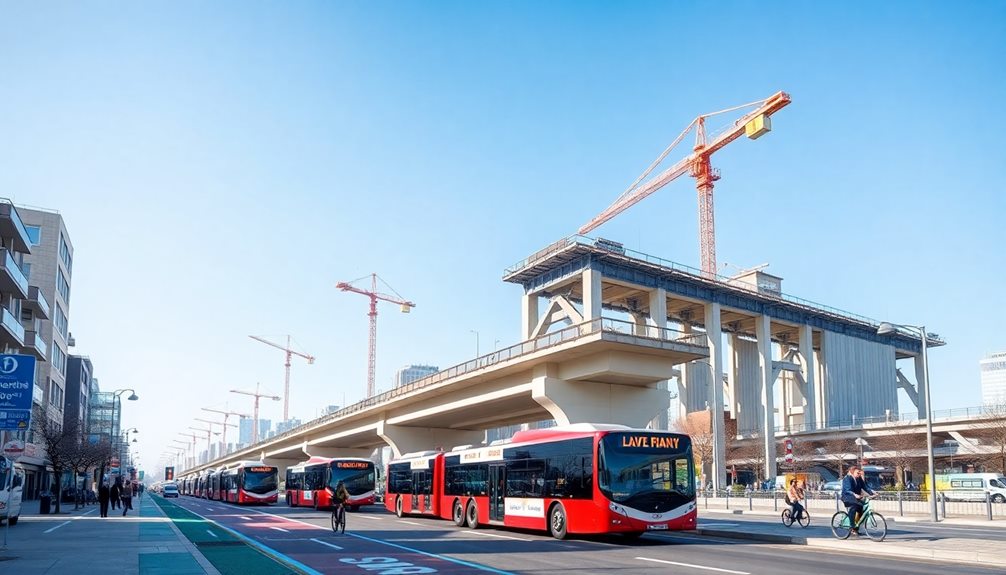
With the IIJA, you're seeing significant investments in enhancing public transit systems and building a robust electric vehicle charging network.
This funding aims to replace outdated transit vehicles with cleaner options and establish a national network of 500,000 chargers.
These improvements not only boost efficiency but also support the shift to sustainable transportation.
Enhanced Public Transit Systems
Modernizing public transit systems is essential for creating accessible and reliable transportation options that cater to urban commuters. The Infrastructure Investment and Jobs Act (IIJA) allocates $39.2 billion specifically for this purpose over the next five years. This funding aims to replace deficient transit vehicles with zero-emission options, promoting both environmental sustainability and cleaner air quality in cities.
Investments in public transportation can greatly enhance service quality and infrastructure, contributing to the well-being of diverse populations. Remarkably, the Reconnecting Communities program dedicates $1 billion to dismantling barriers faced by disadvantaged communities, ensuring equitable access to transit services.
Key benefits of this funding include:
- Job Creation: Thousands of jobs will emerge from these investments, boosting local economies.
- Cleaner Environment: Shifting to zero-emission options will improve air quality and reduce greenhouse gas emissions.
- Enhanced Accessibility: Modernized systems will better serve urban commuters, making public transit more user-friendly.
As we embrace these changes, the IIJA's support for modernizing public transit systems will pave the way for a more efficient, equitable, and sustainable transportation future.
Electric Vehicle Charging Network
As public transit systems enhance accessibility and sustainability, the focus shifts to the electric vehicle charging network, an essential component of modern transportation infrastructure.
With the Infrastructure Investment and Jobs Act (IIJA) allocating $7.5 billion for this purpose, the goal is to establish 500,000 charging stations across the nation by 2030. This initiative not only facilitates the shift to electric vehicles but also guarantees that charging stations are accessible in both urban and rural areas, making clean transportation more feasible for everyone.
Fast-charging stations will be installed along highways and in public spaces, alleviating range anxiety for electric vehicle owners. By prioritizing the development of a thorough electric vehicle charging network, the IIJA actively supports the reduction of greenhouse gas emissions and promotes the use of zero-emission vehicles.
Moreover, this investment is expected to lead to significant job creation in the construction and maintenance of these charging stations.
Broadband Expansion Initiatives
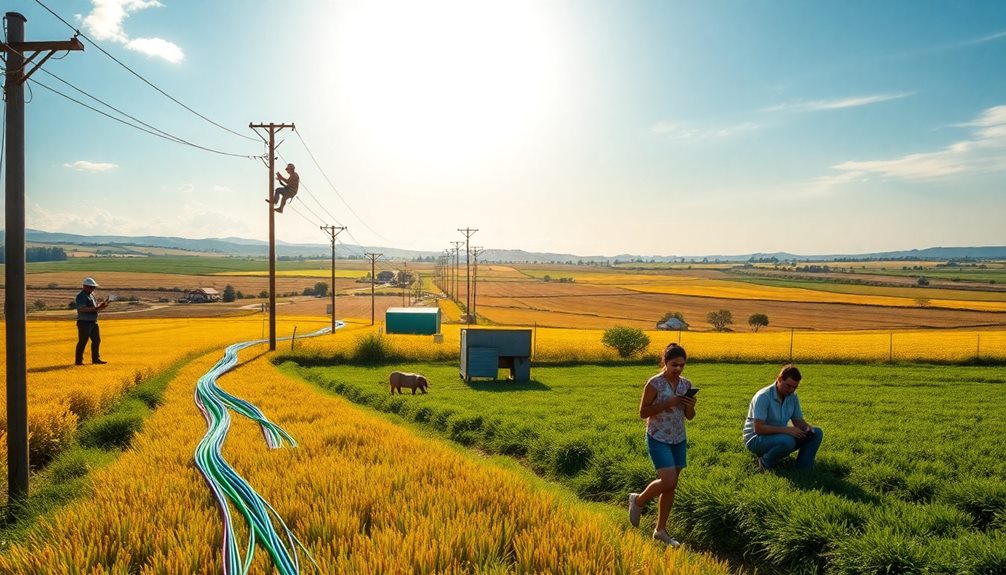
Access to reliable internet is a fundamental right in today's digital age, and the Infrastructure Investment and Jobs Act (IIJA) is making strides to guarantee that over 30 million Americans benefit from it.
The IIJA allocates $65 billion specifically for broadband expansion initiatives, targeting underserved rural areas and promoting affordable broadband access.
Key components of these initiatives include:
- ReConnect Program: Focuses on extending broadband infrastructure to rural communities.
- Funding for State and Local Governments: Grants to enhance cybersecurity measures for networks.
- Economic Growth and Educational Opportunities: Improved connectivity fosters job creation and better access to learning resources.
Water Infrastructure Funding
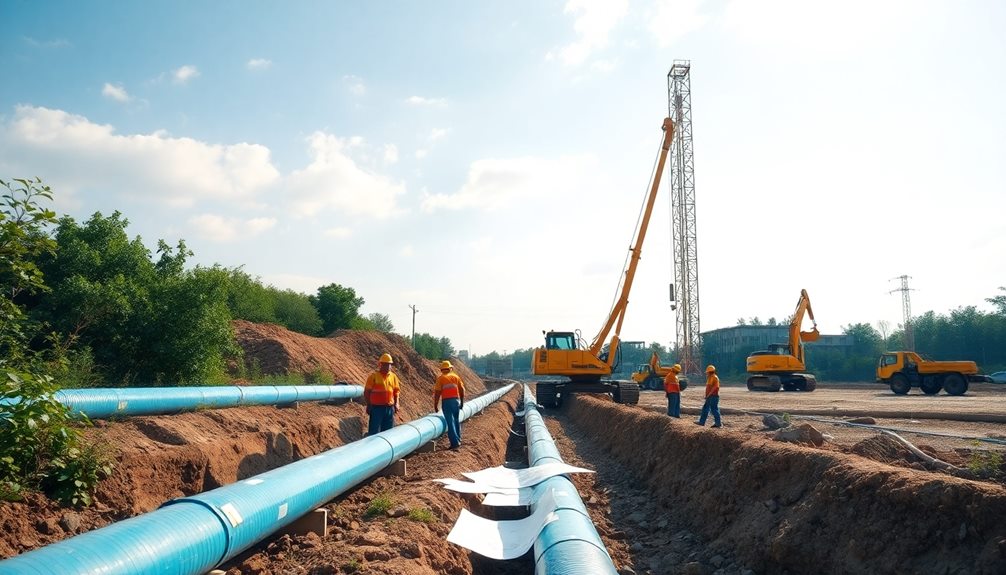
With the IIJA allocating $15 billion specifically for lead pipe replacement, your community can finally work towards safer drinking water.
Additionally, the $23.426 billion for Drinking Water and Clean Water State Revolving Funds will help states upgrade their water systems.
These investments are essential for ensuring reliable and clean water access for everyone.
Lead Pipe Replacement
Lead pipes, once a common feature in water systems, are now recognized as a significant health hazard that can contaminate drinking water. The Infrastructure Investment and Jobs Act (IIJA) allocates $15 billion specifically for lead service line replacement initiatives aimed at improving public health.
This funding is essential for eliminating lead pipes in public water systems, particularly in areas disproportionately affected by lead contamination.
Here are some key points about the lead pipe replacement initiative:
- The IIJA funding focuses on replacing lead service lines to reduce lead exposure.
- It prioritizes communities with the highest health risks, especially for children and pregnant women.
- The Environmental Protection Agency (EPA) oversees these efforts as part of a broader $50 billion investment in water infrastructure.
State Revolving Funds
State Revolving Funds (SRFs) play a crucial role in enhancing water infrastructure across the United States. The Infrastructure Investment and Jobs Act (IIJA) allocates $23.426 billion to Drinking Water and Clean Water SRFs, empowering states to tackle critical infrastructure projects.
With $15 billion specifically for lead service line replacement, this funding addresses urgent public health concerns linked to lead contamination in drinking water. Additionally, states can access $10 billion to implement treatment solutions for harmful pollutants like per- and polyfluoroalkyl substances (PFAS).
These efforts are fundamental for safeguarding community health and guaranteeing that your local water supply remains safe and clean. The SRFs offer low-interest loans to local communities, making it easier for them to finance necessary infrastructure projects.
By leveraging this funding, states can modernize their water systems, enhancing resilience and sustainability. This aligns perfectly with the broader goals of the IIJA, which aims to improve infrastructure and protect public health across the nation.
Climate Resilience Investments

Climate resilience investments are essential for safeguarding our infrastructure against the growing threats posed by climate change. The Infrastructure Investment and Jobs Act (IIJA) allocates a significant $47.2 billion specifically for resiliency initiatives, spanning areas like flood mitigation and ecosystem restoration to enhance infrastructure durability.
With $21 billion dedicated to cleaning up legacy pollution, this funding addresses environmental hazards and promotes healthier ecosystems.
Key aspects of these climate resilience investments include:
- Flood Mitigation: Supporting local and state efforts to reduce risks from severe weather events.
- Zero-Emissions Economy: Investing in innovative technologies that bolster energy infrastructure against climate-related disruptions.
- Community Engagement: Ensuring disadvantaged communities receive targeted investments, fortifying their infrastructure against climate challenges.
Safety Enhancements in Infrastructure

When you think about infrastructure safety, you can't ignore the significant impact of the Bipartisan Infrastructure Law.
With stronger regulations for hazardous materials and increased funding for safety protocols, your community stands to benefit from improved transportation safety.
These enhancements not only protect lives but also guarantee a more reliable infrastructure for everyone.
Improved Safety Protocols
Improved safety protocols are essential for guaranteeing the secure transportation of hazardous materials, and the Bipartisan Infrastructure Law (BIL) is stepping up to enhance these measures.
With increased funding, the BIL focuses on advancing the safety authority of the Pipeline and Hazardous Materials Safety Administration (PHMSA) to modernize infrastructure systems. This legislation aims to reduce risks associated with hazardous materials transportation, ultimately promoting public health.
Key elements of the BIL include:
- Enhanced training programs to improve the skills of personnel handling hazardous materials.
- Modernized infrastructure systems designed to meet higher safety standards across various transportation sectors.
- Ongoing assessments of funding effectiveness to guarantee that safety protocols are continually improved.
Hazardous Materials Regulations
The Bipartisan Infrastructure Law (BIL) not only enhances safety protocols but also strengthens hazardous materials regulations to better protect public health and the environment. By increasing funding and boosting the authority of the Pipeline and Hazardous Materials Safety Administration (PHMSA), the BIL aims to modernize infrastructure systems related to hazardous materials.
Here's a quick look at the BIL's key contributions:
| Aspect | Details | Impact |
|---|---|---|
| Federal Investment | Significant funding allocated for safety standards | Improves overall safety in transportation |
| Training | Enhanced training programs for hazardous materials | Reduces incidents and promotes best practices |
| Safety Standards | Updated regulations for hazardous materials handling | Protects public health and the environment |
| Compliance | Ongoing assessments of infrastructure systems | Guarantees adherence to safety protocols |
| Transparency | Public access to information on safety enhancements | Promotes accountability and awareness |
With these measures, you can expect a marked improvement in the handling and transportation of hazardous materials, ultimately fostering a safer environment for everyone.
Compliance and Requirements
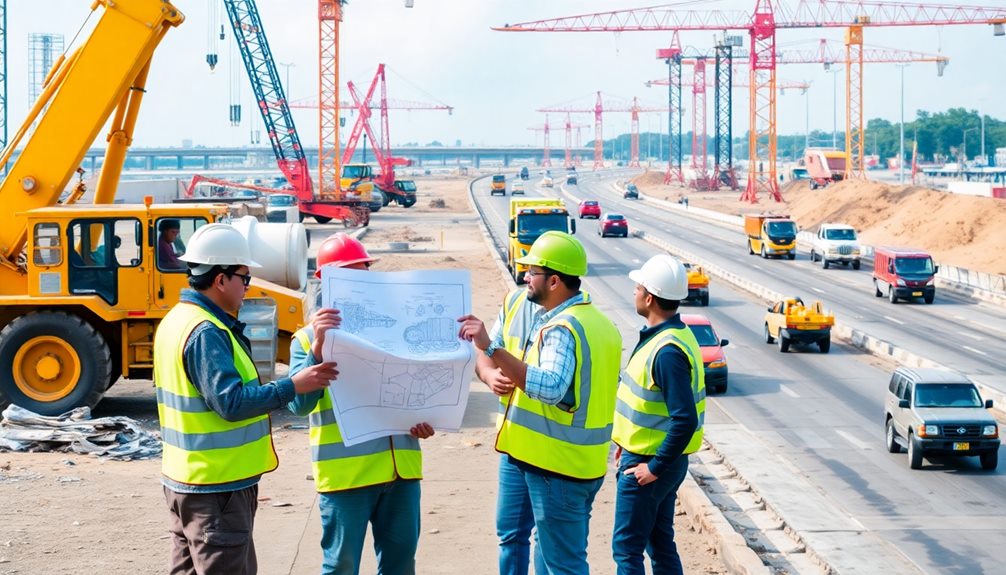
Compliance with the Buy America, Build America Act is essential for all infrastructure projects funded under the IIJA. This act mandates that all iron and steel used must be produced in the U.S., while manufactured products should have over 55% U.S. content.
Meeting these compliance requirements guarantees that your project aligns with national priorities.
To maintain transparency and accountability, you'll need to be aware of several key requirements:
- Adhere to environmental and safety regulations, especially those enhanced by the Pipeline and Hazardous Materials Safety Administration (PHMSA).
- Regularly update and assess the effectiveness of your funding to guarantee compliance with legislative objectives.
- Align your project with the Justice40 Initiative, committing 40% of funds to benefit disadvantaged communities.
Justice40 Initiative Overview

Maneuvering through the complexities of federal funding can be intimidating, especially when it comes to initiatives like Justice40. This initiative aims to guarantee that 40% of federal funding under the Infrastructure Investment and Jobs Act (IIJA) is directed toward disadvantaged communities. It addresses systemic inequities in infrastructure investment by focusing on clean energy, affordable housing, and workforce development.
The Climate and Economic Justice Screening Tool helps identify marginalized communities that would benefit from the Justice40 program, guaranteeing resources are allocated effectively. Here's a quick overview of the key elements:
| Focus Area | Description |
|---|---|
| Disadvantaged Communities | Targeting those most in need |
| Infrastructure Investment | Enhancing community resilience |
| Clean Energy | Promoting sustainable energy solutions |
| Economic Opportunity | Creating jobs and workforce development |
| Environmental Justice | Addressing historical inequities |
This commitment represents a significant effort to promote sustainable development in historically underserved areas. By prioritizing these investments, the Justice40 Initiative works towards a more equitable future, guaranteeing that all communities can thrive.
Resources for Implementation
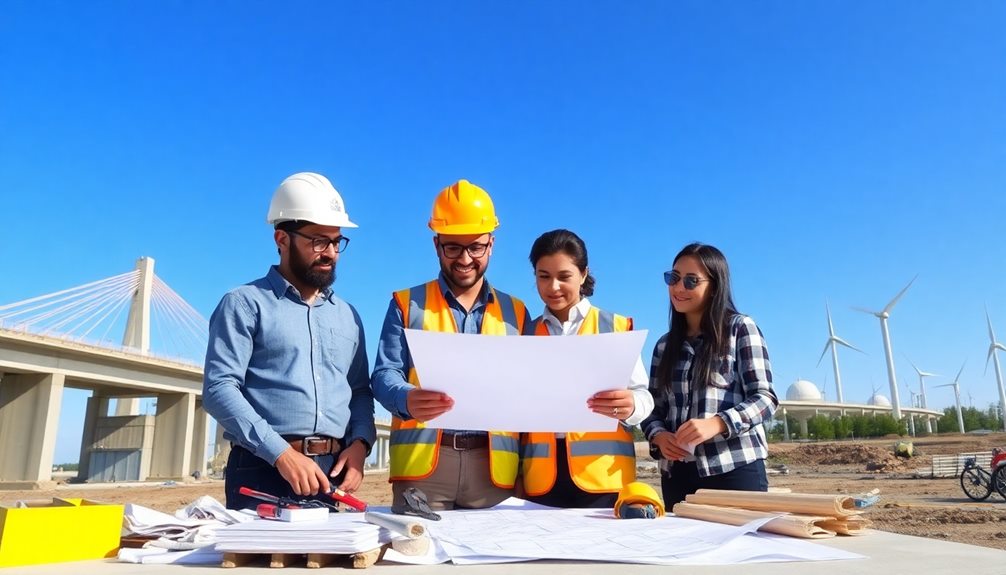
Steering the resources available for implementing the Infrastructure Investment and Jobs Act (IIJA) can greatly enhance your community's ability to access essential funding. By leveraging these resources, you can effectively navigate the complexities of infrastructure projects. The Department of Transportation (DOT) offers invaluable tools to aid you in this process.
Here are some key resources to reflect upon:
- DOT Navigator: This tool helps you navigate grant applications and identify funding opportunities under the IIJA.
- BIL Launchpad: This platform provides tailored information and technical support for implementing infrastructure projects.
- GFOA Federal Liaison Center: Stay updated on ongoing resources and transparency regarding IIJA funding allocations.
Collaborating with local governments and organizations is fundamental for maximizing the impact of IIJA funding. Expert teams are available to provide strategic guidance throughout the implementation process.
Frequently Asked Questions
What Is the Meaning of Infrastructure Funding?
Infrastructure funding means the financial resources you allocate for building and maintaining essential systems like roads, bridges, and water supply networks.
It's about investing in your community's future, ensuring safe and efficient transportation, and improving overall quality of life.
This funding supports projects that enhance safety and resilience against challenges like climate change.
What Is the Infrastructure Bill Funding?
The infrastructure bill funding refers to a significant financial allocation aimed at modernizing various sectors across the nation.
You'll see investments in public transportation, broadband access, water quality improvements, and airport enhancements.
With over $1.2 trillion allocated, it's designed to replace outdated systems and improve services.
This funding targets critical areas like zero-emission transit vehicles, high-speed internet, lead replacement, and efficient air travel, ultimately enhancing the quality of life for communities everywhere.
How Does Iija Funding Work?
The IIJA funding works by allocating about $1.2 trillion to improve infrastructure across the U.S.
You'll see $550 billion dedicated to new investments and programs, distributed through federal formulas over five years. Competitive grants encourage innovative projects, promoting collaboration between local and state governments.
Key areas include roads, bridges, public transit, and broadband. Plus, you must comply with the Buy America, Build America Act, ensuring materials come from U.S. manufacturers.
How Does Infrastructure Get Funded?
Infrastructure gets funded through a mix of federal, state, and local sources.
You'll often see federal grants distributed based on formulas that consider population and needs. States then allocate these funds for specific projects. Competitive grants also incentivize innovative solutions.
Additionally, local governments may raise funds through taxes or bonds.
It's essential to guarantee that all projects comply with regulations, prioritizing local materials and long-term planning for sustainable development.
Conclusion
In summary, the IIJA funding opens doors for transformative changes in our infrastructure. It promotes safer roads, expands high-speed internet access, revitalizes water systems, and prioritizes equity through the Justice40 Initiative. As you engage with these opportunities, remember: invest in your community, advocate for sustainable practices, and embrace innovation. Together, we can build a stronger, more resilient future. So, let's seize this moment, harness these funds, and pave the way for lasting progress.

